Rockfish
These fish can grow up to three feet long!
Advertisement
Rockfish Scientific Classification
Read our Complete Guide to Classification of Animals.
Rockfish Conservation Status
Rockfish Facts
- Prey
- Shrimp, crab, and greenlings
- Group Behavior
- School
- Fun Fact
- These fish can grow up to three feet long!
- Estimated Population Size
- More than 400 million fishes
- Most Distinctive Feature
- Vibrant colors
- Gestation Period
- Can be several days to several months
- Habitat
- Bering Sea, North Pacific, and the Aleutian Islands
- Predators
- Harbor seals, salmonids, and lingcod
- Diet
- Omnivore
- Favorite Food
- Shrimp, crab, and greenlings
- Type
- Fish
- Common Name
- Rockfish
- Number Of Species
- 100
View all of the Rockfish images!
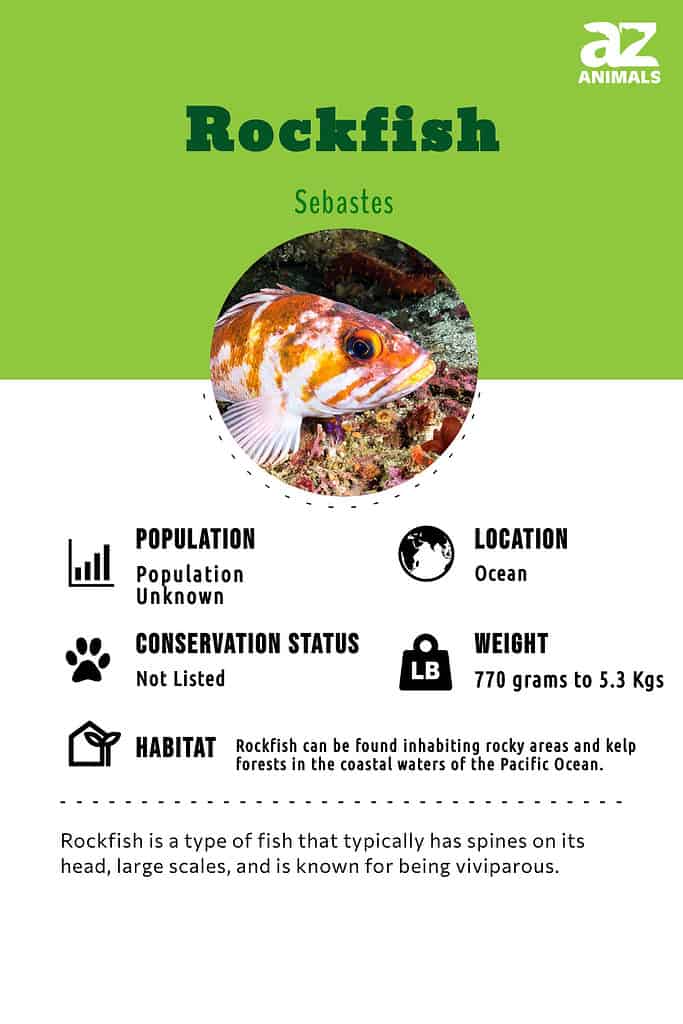
Rockfish come in a variety of colors like red, yellow, orange, black, and dark green.
Rockfish are a huge family of about 100 different species that come in various shapes, sizes, and colors. About thirty-two of these 100 fishes are found in the Gulf of Alaska.
These fishes can get huge and some of them can even grow up to three feet. They come in a variety of colors like red, yellow, orange, black, and dark green. Some of these fishes have poisonous spines on their dorsal fins.
These fishes can weigh anywhere from around 770 grams to 5.3 Kgs. They are viviparous which means that they give birth to hundreds and thousands of tiny live larvae after a process of internal fertilization.
They are usually fed on by harbor seals, salmonids, and lingcod. In turn, they feed on shrimps, crabs, and greenlings among other fishes.
These fishes are known to have long lives. Some of them are known to live for about 120 years. Some types of rockfish include rosefish, yelloweye rockfish, and deep-water redfish.
Incredible Rockfish Facts!
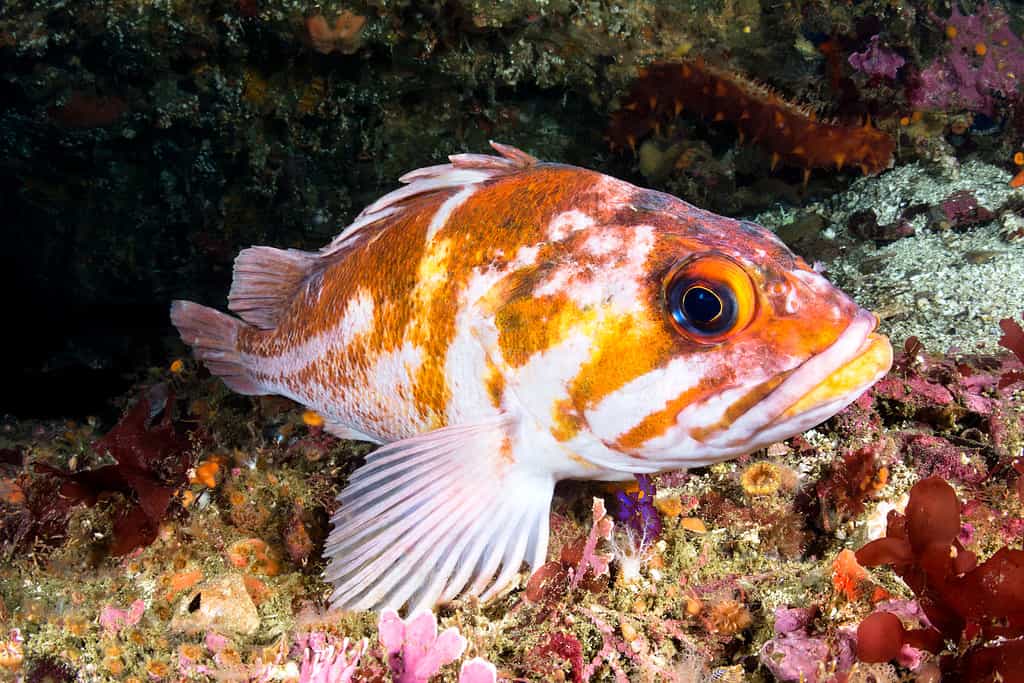
These fish can grow as long as three feet, and certain ones possess venomous spines located on their dorsal fins.
©Joe Belanger/Shutterstock.com
- Huge size: These fishes can get up to three feet long. Some of these fishes have poisonous spines on their dorsal fins.
- Viviparous: These fishes give birth to thousands of tiny larvae after internal fertilization.
- Groups or solitary: Some of these fishes are known to exist in groups that are known as schools. However, some of them like to remain solitary.
- Motion-less: These fishes are excellent in pretending that they are motionless mid-water.
- A substantial number of species: There are about 100 distinct species of rockfish. About thirty-two of these rockfishes are found in the Gulf of Alaska alone.
Classification and Scientific Name
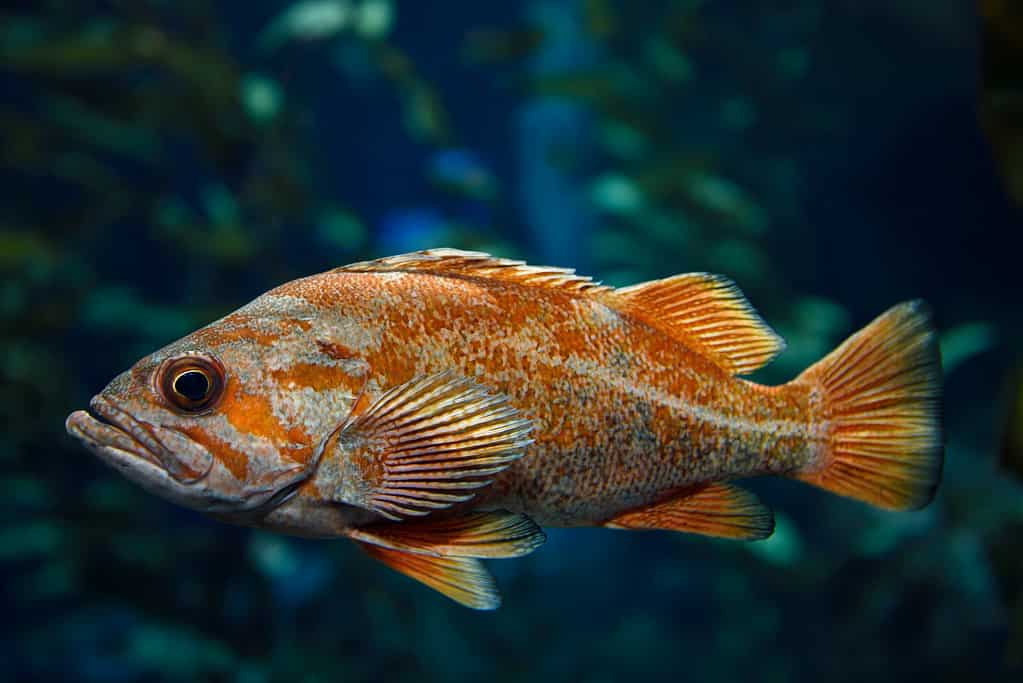
These fish are classified under the Animalia family and Chordata phylum. They are categorized as members of the Actinopterygii class and Scorpaeniformes order.
©Reimar/Shutterstock.com
These fishes belong to the family Animalia and phylum Chordata. These fishes come from the class Actinopterygii and order Scorpaeniformes. They go by the scientific name Sebastes. These fishes also belong to a genus which is also named Sebastes.
The word Sebastes comes from an ancient Greek word – σεβαστός, or sebastós. It translates to mean “venerable” or “august.” Venerable means that something is owed respect for its age, character, or the wisdom it holds, which suits the rockfish well. Considering that the fish can live up to 140 years, this adjective describes it nicely.
Different Types
- Pacific ocean perch
- Yelloweye rockfish
- Canary rockfish
- Quillback rockfish
- Copper rockfish
- Black rockfish
- Shortraker rockfish
- Bocaccio
- China rockfish
- Sebastes rufus
- Sebastes melanostomus
- Sebastes aurora
- Vermilion rockfish
- Widow rockfish
- Blue rockfish
- Yellowtail rockfish
- Tiger rockfish
- Rougheye rockfish
- Brown rockfish
- Lingcod
- Cabezon
- Sebastes goodei
- Redbanded rockfish
- Pygmy rockfish
- Sebastes ciliatus
- Sebastes elongatus
- Sebastes diaconus
- Sebastes reedi
- Sebastes zacentrus
- Sebastes brevispinis
- Sebastes proriger
- Sebastes polyspinis
- Stripetail
- Sebastes diploproa
- Sebastes jordani
- Sebastes helvomaculatus
- Sebastes emphaeus
- Sebastes variegatus
- Darkblotched rockfish
- Shortspine thornyhead
- Sebastes norvegicus
- Striped bass
- Hyalinobatrachium talamancae
- Olive rockfish
- Gopher rockfish
- Sebastes inermis
Species
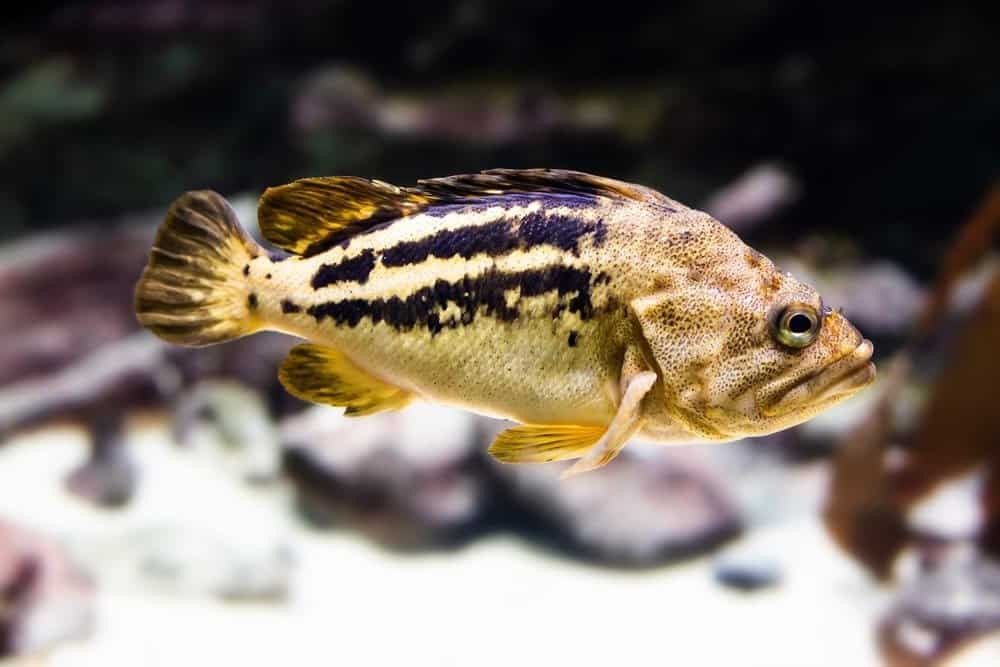
These fish are classified under the Animalia family and Chordata phylum. They are categorized as members of the Actinopterygii class and Scorpaeniformes order.
©Besjunior/Shutterstock.com
There are about 100 different species of rockfish. All of them come in different shapes, sizes, and colors. Out of the 100 different types, some types include rosefish, yelloweye rockfish, and deep-water redfish.
Though these fish are genetically similar, they can look much different between each species. Understanding why they are different can make a big difference in fishing, cooking, and spotting them.
Some common rockfish species include:
- Deacon rockfish: The Deacon Rockfish has a blue tinge to the body with a pink fin, dark coloration, and a protruding jaw, though it is commonly confused with the Blue Rockfish. It commonly resides in rocky reefs, spreading itself from the northern offshore regions of California to southern British Columbia.
- Vermillion rockfish: With a rough and scaly underside along the jaw, the Vermillion rockfish likes to go after octopus as their food, as well as squid and octopus. Even with their small 20-inch body, the female can hold over 280,000 eggs.
- Copper rockfish: This orange and white speckled fish likes to journal from shallow depths of just 33 feet too deep dives of 600 feet. It has a long gestation period, lasting ten months before it gives birth to live young.
- Tiger rockfish: The bright orange and deep red bars along the body give this rockfish the tiger-like appearance that it is named for. It tends to be aggressive towards other breeds, and it is found in many regions, from the central California coast to just off Kodiak Island.
Appearance

It is common knowledge that these fish possess big scales and spines located on their heads.
©Besjunior/Shutterstock.com
These fishes are known to have large scales and they have spines on their heads. They also have gill covers and fins. Some of them have poisonous spines on their dorsal fins, which may have spots along them to differentiate between the species.
Much like the coloring, the size of the rockfish will vary significantly with the species. In general, an average adult can grow up to 8 to 40 inches from the tip of their tail to the curl of their lips. These fishes weigh from 770 grams to 5.3 kgs. The dorsal and anal fins vary from species to species but have incredibly sharp angles.
There are about thirty-two species of these fishes in the Gulf of Alaska. These fishes come in a variety of colors like black, green, orange, and red. Some of these fishes also have stripes and/or splotches on the body, helping anyone to get a better idea of which species they may have caught. Some fish even have striping.
Distribution, Population, and Habitat
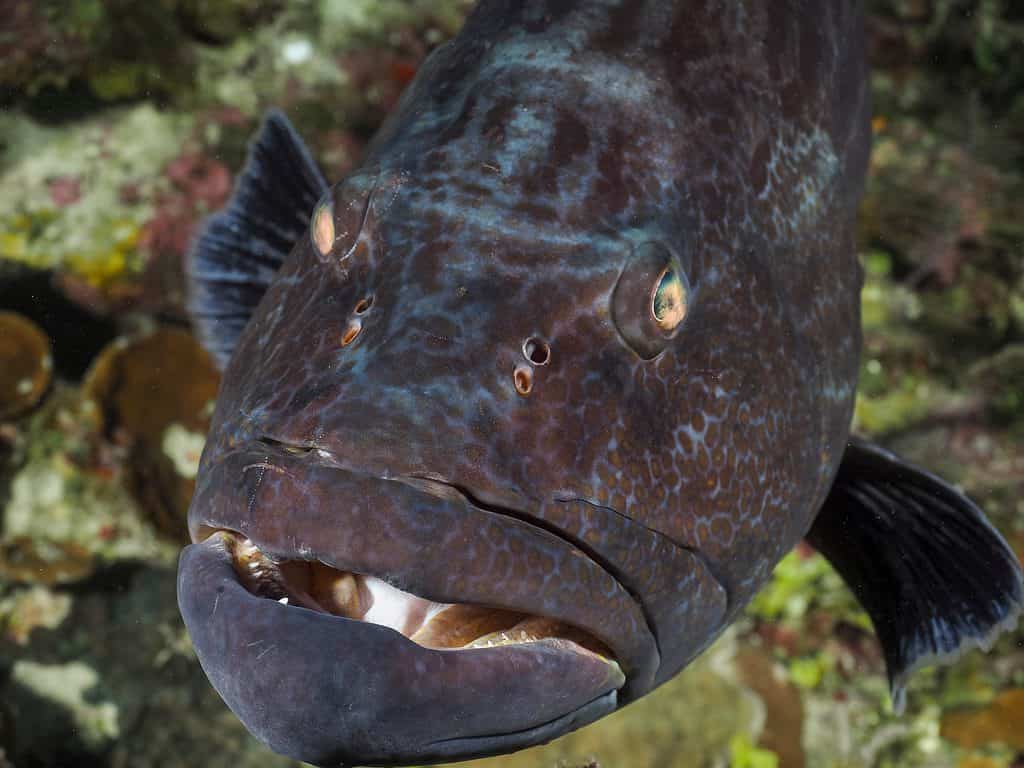
They are large, dark-colored fish that can weigh up to 180 pounds, reach five feet long, and live over 30 years, but experts say most are caught before living to this ripe old age and size.
©Jesus Cobaleda/Shutterstock.com
These fishes are deep-water fishes and are usually found between 31 and 66 degrees. They are known to be found in the North Pacific, Bering Sea, and the Aleutian Islands. Besides that, these fishes are also found in California and San Diego. In the Gulf of Alaska, there are about thirty-two rockfishes.
In 1997, there were more than 400 million rockfish around the world. Currently, they have been declared to be not extinct. There are several types of rockfishes. Some of them include rosefish, yelloweye rockfish, and deep-water redfish.
Predators and Prey
Like almost all other living creatures, these fishes are an important part of the ecosystem and are preyed upon by several predators. Though they are aggressive with crustaceans, they also experience their fair share of predators.
What Does the Rockfish Eat?
To get enough nutrition in their body, rockfish seek out crabs, shrimp, greenlings, and Pacific herring in their diet, depending on what is available within their habitat. Amphipods, which look much like shrimp, are another useful source of nutrients for rockfish and are predominantly found in freshwater.
What Eats Rockfish?
The common predators of the rockfishes include harbor seals, salmonids, and lingcod. The China rockfish is hunted by much bigger animals, like dolphins and sharks, since they are an excellent source of protein.
Reproduction and Lifespan

Every fish belonging to the Rockfish group is viviparous, meaning that their reproduction takes place internally, and the offspring are born following internal fertilization.
©iStock.com/joebelanger
All the fishes that make up the Rockfish clan are viviparous which means that the reproduction in these fishes occurs internally and the babies are born after internal fertilization.
The gestation period lasts up to several months after which the fishes give birth to thousands of babies or larvae – most of which are eaten by other fishes as they are carried away by the water currents across the seas and oceans.
These fishes live long lives, and some have even lived to 140 years. Learn about the longest-living animals here.
Fishing and Cooking
Rockfishes can very well be fished out cooked. They are known to have a mildly sweet flavor and a nutty crunch. Their flesh is mediocrely firm and has medium-sized flakes.
The most classic way to prepare this fish is with fresh herbs and lemon, much like you would prepare salmon. However, being a saltwater fish, some people compare the flavor to that of striped bass or ocean perch.
View all 114 animals that start with RRockfish FAQs (Frequently Asked Questions)
Where are rockfish found?
These fishes are found in the Bering Sea, North Pacific, and the Aleutian Islands. Besides that, these fishes are also found in California and San Diego. In the Gulf of Alaska, there are about thirty-two rockfishes.
What is rockfish similar to?
Rockfishes are similar to a host of fishes including rock cod, redfish, and striped bass.
Are Rockfish herbivores, carnivores, or omnivores?
Rockfish are Omnivores, meaning they eat both plants and other animals.
What Kingdom do Rockfish belong to?
Rockfish belong to the Kingdom Animalia.
What phylum do Rockfish belong to?
Rockfish belong to the phylum Chordata.
What class do Rockfish belong to?
Rockfish belong to the class Actinopterygii.
What order to Rockfish belong to?
Rockfish belong to order Scorpaeniformes.
What type of covering do Rockfish have?
Rockfish are covered in Scales.
What are some predators of Rockfish?
Predators of Rockfish include harbor seals, salmonids, and lingcod.
What is the lifespan of a Rockfish?
Rockfish can live for up to 120 years.
How many species of Rockfish are there?
There are 100 species of Rockfish.
What is a distinguishing feature of the Rockfish?
Rockfish have vibrant colors.
How many Rockfish are left in the world?
There are more than 400 million Rockfish left in the world.
What is an interesting fact about Rockfish?
Rockfish can grow up to three feet long!
How do Rockfish have babies?
Rockfish lay eggs.
Thank you for reading! Have some feedback for us? Contact the AZ Animals editorial team.
Sources
- Monterey Bay Aquarium, Available here: https://www.montereybayaquarium.org/animals/animals-a-to-z/rockfish
- Seattle Aquarium, Available here: https://www.seattleaquarium.org/blog/winter-fishtival-rockfish-fun-facts
- Alaska Department of Fish & Game, Available here: chrome-extension://ohfgljdgelakfkefopgklcohadegdpjf/https://www.adfg.alaska.gov/static/education/wns/rockfish.pdf
- Oregon Department of Fish & Wildlife, Available here: https://myodfw.com/articles/rockfish-identification-tips
- Wikipedia, Available here: https://en.wikipedia.org/wiki/Rougheye_rockfish
- Encyclopedia of Puget Sound, Available here: https://www.eopugetsound.org/science-review/7-rockfish
- California Department of Fish & Wildlife , Available here: https://wildlife.ca.gov/Conservation/Marine/Groundfish/Nearshore-Finfish

















